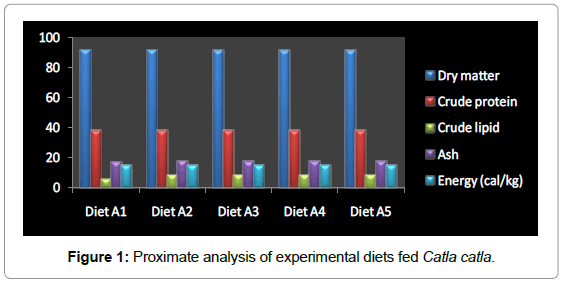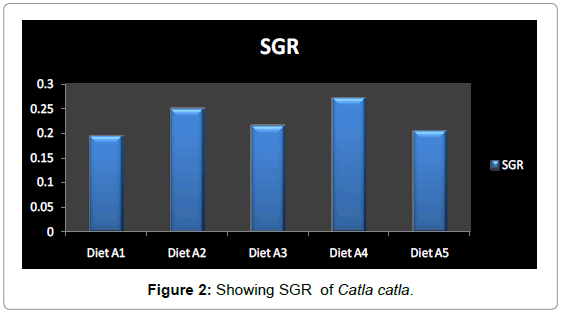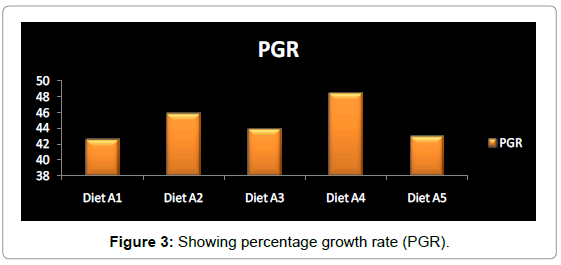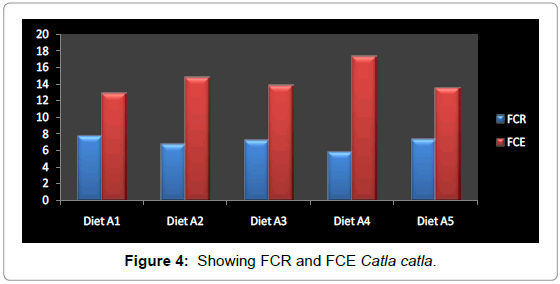Research Article Open Access
Effect of Fish Oil Substitution with Sunflower Oil in Diet of Juvenile Catla catla (Ham) on Growth Performance and Feed Utilization
Dalbir SP*, Roopma G, Ritu K, Vaini G and Shivalika R
P.G Department of Zoology, University of Jammu, Jammu and Kashmir 180006, India
- *Corresponding Author:
- Dalbir SP
P.G Department of Zoology
University of Jammu
Jammu and Kashmir 180006, India
Tel: 0191- 2430830, 2431939
E-mail: dalbirparihar@gmail.com
Received Date: July 04, 2015; Accepted Date: August 21, 2015; Published Date: August 28, 2015
Citation: Dalbir SP, Roopma G, Ritu K, Vaini G, Shivalika R (2015) Effect of Fish Oil Substitution with Sunflower Oil in Diet of Juvenile Catla catla (Ham) on Growth Performance and Feed Utilization. J Fisheries Livest Prod 3:144. doi:10.4172/2332-2608.1000144
Copyright: © 2015 Dalbir SP, et al. This is an open-access article distributed under the terms of the Creative Commons Attribution License, which permits unrestricted use, distribution, and reproduction in any medium, provided the original author and source are credited.
Visit for more related articles at Journal of Fisheries & Livestock Production
Abstract
During the present investigation Catla catla fry (0.250 ± 0.008 g) were fed with five iso-nitrogenous (40%) and isolipidic (6%) diets in triplicate @ 5% of body weight, for a period of 60 days. Diet A1 (control)was without supplemented oil i.e., whereas diets A2-A5were supplemented with 3% fish oil (FO) and sunflower oil (SFO) at different proportions i.e. diet A2 with(100% FO), diet A3 (70% FO+30% SFO), diet A4 (50% FO+50% SFO) and diet A5 (70% SFO+30% FO). After the end of 60 days of feeding trail a significant difference (p<0.001) was observed in weight gain (WG), specific growth rate (SGR), feed conversion ratio (FCR), feed conversion efficiency (FCE ) and survival rate in oil supplemented groups as compared to control. The diet A4 shows the best result with 48.84% (WG), 0.193 (SGR) and 5.81 (FCR) 17.31 (FCE) and 96.81% survival rate. However, there was insignificant difference (p>0.01) in all the growth performance parameters between oil supplemented diets i.e. A2-A5. However, diet A1 (control) registered poorest performance i.e. 42.54% (WG), 0.271 (SGR), 7.75 (FCR), 12.88 (FCE) and 93.56% survival rate. The present result thus clearly revealed that sunflower oil could be partially replace the fish oil up to 50% in supplemented diet without any adverse effect on the growth performance of Catla catla fry, as it is less expensive and easily available.
Keywords
Fish oil; Sunflower oil; Growth rate parameters; Survival rate; Catla catla
Introduction
Fish oil derived from wild harvested whole fish currently constitutes the major aquatic protein and lipid source available within the animal feed marketplace. Due to expansion of aquaculture, it is expected that the total use of fish oil by aquaculture sector will decrease in long term. Thus alternatives to use of marine materials in fish feed must be found.
Vegetable oils used as alternative of fish oil consisted lately of an important part of the research on fish nutrition. Nevertheless, lipid digestibility was higher in diets containing vegetable oil than with animal lipid in Atlantic salmon fed diets based on flaxseed oil [1] and in Atlantic halibut fed diets based on vegetable oil [2].
Unlike fish oil, vegetable oils are less expensive and do not accumulate persistent organic pollutants (POPs), thus production costs can be lowered with vegetable oil based diets, as well as contaminant exposure for fish and consumers. Additionally, these feeds will not alter organoleptic properties of the fillets and will be highly digestible for fish.
Dietary lipids play an important role as potential supplier of energy, essential fatty acids and soluble vitamins. They also affect the quality of cultured fish because of their influence on the fatty acid composition of body tissues [3]. The addition of lipids in fish diets contributes to protein sparing by increasing their digestible energy value. Substitution of fish oil (FO) in fish aqua feeds has become inevitable due to the limited global supply of FO [4,5].
Since vegetable oil such as corn, soyabean, peanut, linseed, cotton seed oils contain high levels of n-6 and also significant amounts of n-3 fatty acids, they can be used in Catla catla diets. Takeuchi [6] reported that 5% supplement of corn oil or olive oil resulted in better growth and feed utilization than the addition of cod liver oil.
Thus, the current study investigates the effect of replacement of fish oil with sunflower oil on growth performance parameters, survival rate and body lipid composition of Catla catla fry (Ham.)
Materials and Methods
Culture conditions
Catla catla fry of initial weight 0.250 ± 0.009 were collected from the Govt. Fish Farm Gou Manhasa Jammu. Fish were acclimatized to the experimental conditions for a period of two weeks. During this period, they were fed with rice bran and mustard oil cake (1:1). To determine the initial body composition 20 selected fish on a random basis were killed for biochemical analysis. At the beginning of the experiment, one hundred and twenty five fry were randomly divided into five different groups, the fry were tried in triplicates manner. Fish were kept in plastic tub containers (50 L). Each plastic tub was put in recirculating system maintained at (25 ± 2°C). The entire plastic tub was cleaned up every day in the morning by siphoning off the accumulated waste materials. Fish were then fed with 5% of body weight per day. Each diet was fed twice a day at 9:30 am and 4:00 pm for 60 days to triplicate groups. On the other hand, each group of fish was weighed in the beginning and after every 15 days and the amount of diet fed was adjusted accordingly. After 60 days of feeding, fish were taken out from each treatment; the dorsal muscle tissue of each was dissected and used for carcass composition analysis purposes.
Diet preparation
Five diets were formulated to contain approximately equal amount of digestible protein (40%) and digestible energy (14.86 cl/Kg). Main protein sources (fishmeal, soyabean and mustard oil cake) already grounded in mill was passed as particles through no. 40 (425 μm) mesh sieve. Mineral mix and vitamin mix were purchased from market After all, ingredients were thoroughly mixed, and appropriate quality of water provided (30% for 100 g of mixed ingredients). Diets were supplemented with 3% of the mixture of fish oil (FO) and vegetable oil (VO) at varying levels. Diet A1 (without supplemented oil) diet A2 (with 100% FO), diet A3 (with 75% FO+25% VO) diet A4 (with 50% FO+50% VO) and diet A5 (with 25% FO+75% VO) (Table 1). Dough was passed through an extruder to produce spaghetti and dried at 37oC for two days. So, the concerned dried diet was packaged into plastic bag and stored until its usage.
| Treatments | |||||
|---|---|---|---|---|---|
| Ingredients | A1 | A2 | A3 | A4 | A5 |
| Fishmeal | 39 | 39 | 39 | 39 | 39 |
| Rice bran | 04 | 04 | 04 | 04 | 04 |
| Wheat bran | 04 | 04 | 04 | 04 | 04 |
| Mustard oil cake | 21 | 21 | 21 | 21 | 21 |
| Soyabean oil | 24 | 24 | 24 | 24 | 24 |
| Vegetable waste | 04 | 04 | 04 | 04 | 04 |
| Fish oil(FO) | ----- | 03 | 2.10 | 1.50 | 0.90 |
| Vegetable oil (sunflower oil) | ------ | --- | 0.90 | 1.50 | 2.10 |
| Vitamin+minerals premix* | 01 | 01 | 01 | 01 | 01 |
*Nutrition super forte (Rejuvenating combination of multivitamin and multi minerals,
AROSOL chemicals PVT. Limited)
Vitamin A=700,0001.U; Vitamin D3=140,0001.U; Folic acid=100 mg; Vitamin
E=250 mg; Niacin amide=100 mg; Iron=1500 mg; Iodine=325 mg; Cobalt=150 mg;
Magnesium=6000 mg; Manganese=1500 mg; Zinc=3000 mg; Selenium=10 mg;
Potassium=100 mg; Sulphur=7.2gm; Calcium=270 gm; Phosphorous=130 gm;
Copper=1200 mg; Fluorine=300 mg
Table 1: Composition of experimental diets for Catla catla.
The proximate composition of the experimental diets and samples of the fish muscle were determined by standard methods using hot air oven for moisture, ash, lipid, and protein content respectively (Table 2 and Figure 1).
| Treatments | |||||
|---|---|---|---|---|---|
| Composition | A1 | A2 | A3 | A4 | A5 |
| Dry matter* | 91.62 | 91.54 | 91.19 | 91.25 | 91.20 |
| Crude protein* | 38.10 | 38.07 | 38.08 | 38.09 | 38.05 |
| Crude lipid* | 5.95 | 8.79 | 8.80 | 8.82 | 8.84 |
| Ash* | 17.26 | 17.89 | 17.60 | 17.65 | 17.69 |
| Energy (cal/Kg) | 14.87 | 14.95 | 14.89 | 14.97 | 14.93 |
*presented in percentage of dry weight
Table 2: Proximate analysis of experimental diets fed Catla catla.
Sampling and growth measurement
The fishes from each tub were captured once in a fifteen days and were weighed individually and their growth was assessed by calculating following growth parameters.
Percentage weight (%WG): It was calculated by using the formula:
%WG=[(Wf-Wi)/ Wi] × 100
Where Wf is the final weight of the fish Wi is the initial weight of the fish.
Specific growth rate: The formula used for calculating SGR was:
SGR=(In final weight-In initial weight) × 100
No. of days of experiment
Feed conversion ratio (FCR): the FCR was calculated by using the formula
FCR=Feed fed/Gain in weight of fish
Feed conversion ratio FCE (%): It was calculated by using the formula:
FCE (%)=[(Gain in wet weight of fish/Feed Fed)] × 100
Statistical analysis
A one way analysis (ANOVA) was conducted in each and every experiment, using the computer software ‘Analyses it’.
Results and Discussion
In the present investigation the results related to growth performance of juvenile Catla catla fed on different types of dietary lipids (Table 3). The present results clearly reveal that there was insignificant difference (p>0.01) in growth parameters among various oil supplemented diets A2-A5. However, highest growth performance i.e. 48.48 ± 0.208 and specific growth rate (SGR) 0.271 ± 0.005 was observed in the group A4 ( 50% FO+50% VO sunflower oil) followed by 45.85 ± 1.204 and 0.250 ± 0.001 in diets A2 (100% FO), 42.988 ± 1.777 and 0.215 ± 0.003 in A3 (75% FO+ 25% VO), 43.88 ± 1.777 and 0.204 ± 0.004 in A5 (25% FO+75% VO). Further, there was a significant differences (p<0.01) between Diets A2-A5 with 3% additional dietary oil (9% lipid ) and Diet A1 i.e. Without oil supplementation (6% lipid), which registered a minimum growth increment i.e. 42.54 ± 0.982% and 0.193 ± 0.002 (SGR).
| Treatments | |||||
|---|---|---|---|---|---|
| Parameters | A1 | A2 | A3 | A4 | A5 |
| Initial weight g/fish | 0.2300.009 | 0.261 ± 0.004 | 0.239 ± 0.003 | 0.280 ± 0.007 | 0.233 ± 0.002 |
| Final weight g/fish | 0.329 ± 0.005 | 0.380 ± 0.007 | 0.341 ± 0.001 | 0.424 ± 0.003 | 0.336 ± 0.001 |
| Weight gain g/fish | 0.099 ± 0.003 | 0.119 ± 0.004 | 0.102 ± 0.003 | 0.144 ± 0.004 | 0.103 ± 0.005 |
| SGR | 0.193 ± 0.002 | 0.250 ± 0.001 | 0.215 ± 0.003 | 0.271 ± 0.005 | 0.204 ± 0.004 |
| FCR | 7.75 ± 0.070 | 6.74 ± 0.737 | 7.23 ± 0.292 | 5.81 ± 0.591 | 7.36 ± 0.292 |
| PGR | 42.54 ± 1.777 | 45.85 ± 1.204 | 43.88 ± 1.777 | 48.48 ± .0208 | 42.54 ± 1.777 |
| FCE | 12.88 ± 0.115 | 14.8 ± 1.352 | 13.81 ± 0.518 | 17.31 ± 1.325 | 13.54 ± 0.518 |
| Survival (%) | 93.56 ± 1.045 | 95.76 ± 0.532 | 95.47 ± 1.50 | 96.81 ± 0.50 | 95.26 ± 1.20 |
Table 3: Initial, final weight, weight gain, SGR, FCR, PGR and survival of Catla catla.
Similarly, best FCR and FCE were obtained in group fed on Diet A4. (6.73 ± 0.597 and 14.83 ± 1.325) followed by 6.74 ± 0.655 and 14.80 ± 1.33 in A2, 7.23 ± 0.737 and 13.81 ± 1.352 in A3, 7.36 ± 0.292 and 13.54 ± 0.518 in A5 and least in A1 i.e. 7.75 ± 0.70 and 12.88 ± 0.115.
The present findings are in accordance with Rosenlund [7] in Atlantic salmon, Caballero [8] in tilapia, Mourente [9] in Dicentranchus labrax and Kamaurudin [10] in Tor tambroides , who reported that partial replacement of fish oil up with vegetable oil in fish shows better growth performance without any adverse effect on growth and feed utilization (Table 3). They also attributed this to the sparing effect of dietary protein by increasing dietary lipid levels due to oil supplementation. Bahurmiz and Ng, Gao et al. and Yones et al. [11-13] while working on supplementation of various dietary oils in different fishes reported insignificant differences (p>0.01) in FCR, FCE and PER in groups fed on supplemented Fish oil (FO) and a mixed diet containing Fish oil ,soyabean oil and cottonseed oil. However, fishes fed on a mixed diet perform better in terms of feed utilization. They suggested that better growth performance may be due to presence of a balanced proportion of n-3/n-6 fatty acids in the mixed diet which are required for a better growth and feed utilization in fish.
Result of the present study thus suggested that potential exists for replacing costly FO with 50% of cheap and easily available sunflower oil in the feed of Catla catla juvenile, without compromising the growth performance and feed utilization (Figures 2-4).
References
- Menoy D, Lopez-Bote CJ, Diez A, Obach A, Bautista JM (2007) Impact of n-3 fatty acid chain length and n3/n6 ratio in Atlantic salmon (Salmosalar) diets. Aquaculture 267: 248-259.
- Martins DA, Valente LMP, Lall SP (2009)Apparent digestibility of lipid and fatty acids in fish oil, poultry fat and vegetable oil diets by Atlantic halibut, Hippoglossushippoglossus.LAquaculture 294: 132-137.
- Mukhopadhayay PK, Rout SK (1996 Effects of different dietary lipids on growth and tissue fatty acid changes in fry of carp Catlacatla (Hamilton).) Aquaculture research 27: 623-630.
- Naylor RL, Hardy RW, Bureau DP, Chiu A, Elliott M, et al.(2009) Feeding aquaculture in an era of finite resources. Proceedings of the National Academy of Sciences of the United States of America 106: 15103-15110.
- Turchini GM, Torstensen BE, Ng WK (2009) Fish oil replace- ment in finfish nutrition. Rev Aquacult1: 01−57.
- Takeuchi T, Satoh S, Watanabe T (1983) Dietary Lipids Suitable for the Practical Feed of Tilapia nilotica.Bull Jap Soc Fish 49: 1361-1365.
- Rosenlund G, Obach A, Sandberg, MG, Standal H, Tveit K(2001) Effect of alternative lipid sources on long-term growth performance and quality of Atlantic salmon (Salmosalar L). Aqua Res 32: 323-328.
- Caballero MJ, Obach G, Rosenlund G, Montero D, Gisvold M (2002) Impact of different dietary lipid sources on growth, lipid digestibility, tissue fatty acid composition and histology of rainbow trout, Oncorhynchusmykiss. Aquaculture 214: 253-271.
- Mourente G, Good JE, Bell JG (2005) Partial substitution of fish oil with rapeseed, linseed and olive oils in diets for European sea bass (Dicentrarchuslabrax): effects on flesh fatty acid composition, plasma postaglandins E2 and E2α, immune function and effectiveness of a fish oil finishing diet. Aquaculture Nutrition 11: 25-40.
- Kamarudin MS, Ramezani-Fard E, Saad CR,Harmin SA (2012) Effects of dietary fish oil replacement by various vegetable oils on growth performance, body composition and fatty acid profile of juvenile Malaysian mahseer, Tor tambroides. Aquaculture Nutrition 18: 532- 543.
- Bahurmiz OM, Ng WK (2007) Effect of dietary palm oil source on growth, tissue fatty acid composition and nutrient digestibility of red hybrid tilapia, (Oreochromis sp.), raised from stocking to marketable size. Aquaculture 262: 382-392.
- Gao W, Liu YGJ, Tian LX, Mai KS, Liang GY(2011) Protein sparing capability of dietary lipid in herbivorous and omnivoraus freshwater finfish: acomparative case study on grass carp (Ctenopharyngodonidella) and tilapia (Oreochromisniloticus × O.aureus). Aquaculture Nutrition 17:02-12.
- Yones AM, El-SaidDMSD, Abdel-Hakim NF (2013)Effects of fish oil substitution with vegetable oils in diets of juvenile Nile tilapia, Oreochromisniloticus (L.) on growth performance, nutrients utilization and muscle fatty acids contents. Merit Research Journal of Food Science and Technology 1: 09-18.
Relevant Topics
- Acoustic Survey
- Animal Husbandry
- Aquaculture Developement
- Bioacoustics
- Biological Diversity
- Dropline
- Fisheries
- Fisheries Management
- Fishing Vessel
- Gillnet
- Jigging
- Livestock Nutrition
- Livestock Production
- Marine
- Marine Fish
- Maritime Policy
- Pelagic Fish
- Poultry
- Sustainable fishery
- Sustainable Fishing
- Trawling
Recommended Journals
Article Tools
Article Usage
- Total views: 20346
- [From(publication date):
October-2015 - Mar 29, 2025] - Breakdown by view type
- HTML page views : 15424
- PDF downloads : 4922




